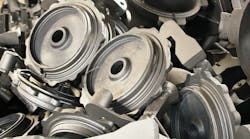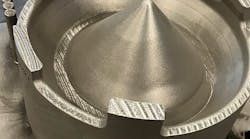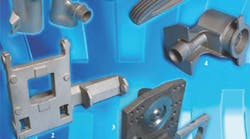There’s nothing particularly new about investment casting as a process, but in recent years it has proven particularly well-suited for sophisticated designs and critical parts in a range of end products, and that success has made investment casters some of the more successful and effective organizations in the metalcasting industry.
Michael C. Perry served as president of the Investment Casting Institute (www.investmentcasting.org) from 1998-2001, during which time he was manager of new business development at Howmet Castings. Today, he is executive director of the Institute, which represents more than 200 distinct investment casting and supplier businesses. In 2006, the North American segment of the industry produced castings valued at more than $3.5 billion. We spoke with Perry in advance of the Institute’s 55th Technical Conference — October 14-17, in Cleveland — and asked him to explain the factors that contribute to the success of this segment of the industry, and what other metalcasters might learn.
The investment casting segment of the US casting industry is reported to be doing quite well. Is it and what are the reasons for this?
Worldwide, the investment casting industry generated about $8.5 billion in sales in 2006, with North America accounting for $3.5 billion of that number. These figures cover engineered components and exclude foundries dedicated to the dental, jewelry, and art segments. The numbers reflect aerospace activity, which includes jet engines, whose dollar content has historically been between 30-40% of each engine manufactured, and airframe components.
In addition to aerospace, industrial gas-turbine sales, for power-generation, marine, and energy-exploration applications, are strong also. Other markets include medical, for joint replacement components, automotive, for high-performance engine and body parts, and sporting goods for all types of products from golf clubs to firearms.
These are just the major categories. Investment casters serve specialized requirements of OEMs serving virtually every sector of the economy. Currently, demand for castings is strong in all the product categories served by investment casters.
Investment casters feel they are somewhat insulated from the “offshoring” trend. Why is this?
While some investment casters have been impacted by the trend to off-shoring, the number is probably much less for this segment of the industry than others. If you step back and look at the overall picture, investment casting has done a fairly good job of hanging onto its customer base and long-running part programs. There are a number of reasons why this has been the case, in my opinion.
First is the technology gap. Investment casting has become the highly specialized segment of the casting industry. Most of the castings that have gone offshore are the less technically sophisticated parts;many companies can make them. This is not the case with investment-cast parts. Components needed for high-temperature applications, or for highly complex designs, are much more difficult to make, so these parts are protected by a technology gap that has emerged over the years between the companies that can cast these kinds of parts and others.
For applications where only the most technically advanced components can pass muster, the casting processes developed in North America, Europe, and Japan still maintain a competitive gap.
Second, I believe that because of the highly technical nature of investment cast parts, those suppliers and customers must work very closely together in a collaborative mode to ensure success. The close relationships developed in this way trump what can be achieved with competitors offshore, many thousands of miles away.
Lastly, because end-product performance is so critical in the systems that depend on investment cast parts, alternate approaches, such as distant suppliers and competing production methods, cannot deliver the technology and close working relationships that more local investment casters can.
Let’s explore the offshoring trend further. How strong is it?
At the height of plant closures, four to five years ago, North America was reported to be losing foundries at a rate of about two per week. That has slowed considerably now; my guess is to less than half that rate, maybe much less than half, but I haven’t seen any recent numbers.
Why is the trend tapering off?
I think the migration among buyers who are able to buy primarily on price has run its course. Countering this trend is the continuous progress that investment casters have made at improving their technology, customer service capabilities, relationships, responsiveness, part performance, and so on.
Many casters contend that the demand for lower prices is as intense as ever. Are investment casters exempt from this trend as well?
Pricing tends to be set according to the value that the casters deliver. The plain truth is that leading OEMs that want their end products to define the state-of-the-art for technical properties, design excellence, durability, performance, and so on, do not have a lot of suppliers they can turn to. For this reason, there is a different list of criteria used to define what it takes to achieve affordability, while still delivering components at the leading edge of technology. Delivering the most advanced parts tends to cost more than delivering parts that have to meet less stringent requirements.
Why are investment casters effective at adding value on these factors?
Investment casters really have no choice but to deliver what customers demand. If they want to work with the world’s best companies, they have to live up to expectations. Those expectations have been increasingly revised upwards over the last two decades. Customer pressure over this time period has encouraged investment casters to achieve unprecedented levels of excellence on a variety of fronts, such as greater precision, higher yields, and in the greater size and complexity of parts that can be cast using the process.
How many process advances in investment casting have been driven by demands for excellence in military applications?
Many have. For example, today’s aircraft are lighter in weight, more powerful, more fuel-efficient, and pioneering new materials, new production processes, and so on. Many of the attractive features in the latest generation of commercial aircraft are the result of technological advances that have trickled down from military applications. Achieving customer expectations in the areas of powerplants and airframe design have created a technology gap.
If you look at the sophistication of single-crystal blades and vanes use in gas turbine engines, to pick one example, it is readily apparent just how large this gap is. Single-crystal technology, which produces a casting with no grain boundaries because the whole casting is grown from a single crystal, and which incorporates air-flow schemes and advanced superalloys, enables the production of components that can function for long-service cycles in high-temperature operating environments. This kind of gas-cooled technology and superior in-use performance is much more advanced than the casting technologies outside the investment casting segment typically produce.
So one factor is that investment casters have improved manufacturing excellence?
True. There are many interesting reasons why investment casting is a highly specialized business. By stepping up to an endless stream of seemingly impossible challenges, investment casters have learned a thing or two. I’d start by pointing out the high degree of design freedom the process now offers. Many of the parts being cast today could not be manufactured by any other process. They would either be physically impossible to produce or they would be so expensive no one would pay for them.
The intricate design of many of today’s parts, with cored passageways, sculpted surfaces, net shapes, asymmetrical geometries, consolidation of dozens, and in some cases even scores, of detail part numbers into a single casting, have slashed costs, streamlined the entire business process, and resulted in superior components.
There is an additional ripple effect of good things that fall out of converting multiple details into a single monolithic casting, including shorter manufacturing lead times, better raw material utilization, reduced downstream operations, and so forth. Best of all, designers keep finding more and more parts that can be converted from fabricated assemblies or forgings into castings, so this too is a factor in the on-going performance of the process to solve problems and grow.
Despite its somewhat secure position, might the offshore migration of work one day have a greater impact on the investment casting segment?
Certainly. If the companies can’t maintain their technological leadership, they may lose business to offshore competitors. This has always been the case. However, the continuous improvement environments many casters have established keep redefining the industry’s capabilities.
These companies have been able to maintain the technology gap between themselves and would-be competitors. But, there are other reasons work goes offshore and it isn’t always for reasons of cost; it can also be to meet the offset requirements imposed on OEMs by some of the countries they do business with, who want to improve their local participation when they make major equipment or infrastructure purchases.
Can the techniques that have helped investment casters insulate themselves from the pain of globalization work for other casters?
I think so. Any foundry that can create a valuable difference in the way it serves customers has a strong defense against losing business. Then, that company also has a platform on which to grow the business. Excellence is the right response to most challenges. Your message seems to be “get better and stay better.” How does the Institute help its members do this?
Helping our members sharpen competitiveness is our primary mission. We do this in a lot of ways, a good example of which is our upcoming technical conference in Cleveland. In addition to this annual event, we also hold a management conference, at which the leadership of our member organizations gather to hear forward looking presentations on a range of topics. In addition to these two annual events, we publish a variety of information in our monthly magazine, INCAST, in books, technical papers, videos, and so on.
We are also active in the training of member employees and are increasing our involvement with universities that offer investment casting education. We also promote the process at design trade shows around the country, so that engineers can see some of casting solutions that save time and money while resulting in better products. We do many more things to disseminate information and to represent our industry to government, so the Institute is extremely busy serving its members.
What are the outcomes of all this effort?
Our growing membership is supportive of the Institute. They applaud our successes in the areas of outreach—to industrial designers, academia, government and broader involvement with our industry development activities through scholarships and community programs.
You have painted a rosy future for the investment casting process. What concerns to you have, if any, about the future?
A good percentage of the investment casting industry in North America is its aerospace and IGT (industrial gas turbine) business. Anything that threatens those sectors can have an unfavorable impact on growth.
However, projections for air travel are very bullish, with 9 billion air passengers per year estimated to be flying by 2025. Other sectors of the industry, those casters who serve automotive, IGT, medical, recreational, and dozens of other sectors, still have a good buffer of available capacity to absorb the increasing work coming along, so they are poised for growth. The bottom line is that things look good for our membership, in every industry segment investment casters serve, for many years to come.
| Here’s how it’s done: Investment Casting The investment casting process starts with manufacturing of an expendable pattern that has the same geometry as the desired finished component. Typically, patterns are made from wax that has been injected into a die. Once produced, the wax pattern is assembled with other wax patterns to form a mold. The wax assembly is repeatedly dipped into a slurry, showered with a sand stucco, and dried. Once the mold has dried, the assembly goes into an autoclave to melt out the wax. Sometimes an additional step in a furnace is needed to burn out all the wax. Then, the mold is heated to a specific temperature and filled with molten metal, which will solidify into a casting. Once the casting has cooled, the mold material is removed and the casting is ready for finishing operations. A more detailed, diagrammed overview of the process is available at online at www.wtec.org/loyola/rp/10_01.htm |
Every year, the Investment Casting Institute reviews products developed by its member companies to select the best designs, which are exhibited at the annual ICI Technical Conference. This year’s contest will be presented October 14-17, at the conference: Here’s an early look:
1. Motorcycle Exhaust Transition — MCM Precision Castings Inc. (www.mcmpc.com), Weston, OH, designed and produces this unitary casting that is an exhaust transition for a motorcycle engine. Produced in two sizes, 7.5 3.55 in. and 4.552.5 in., in 429 stainless steel, this design leaves no welds or seams that may obstruct the flow of the exhaust. The single casting replaces three pieces that had to be stamped and formed, and then welded. The savings, in terms of production time and costs, were “substantial,” ICI details. “This component was tried as a fabricated weldment, but could not achieve the flow numbers or horsepower rating achieved by casting,” according to ICI. “This thin-walled casting was produced with minimal gating so as not to interfere with polishing/ plating requirements. Alloy used is not normally used in investment casting. All exhaust parts had to be made of same material for greater reliability.
2. Clamp in Vertical Conveyor — Becker Metal Works (www.beckermetalworks.com), St. Clair, MI, designed and produces this 1282.5 in. clamp in carbon steel, as a replacement for a two-piece assembly. Investment casting brought savings to the production of the part that had been assembled from machined bar stock, in terms of raw materials, assembly time, and machining time. “The customer needed 400 parts in eight weeks, and machining from bar stock would have taken too long,” ICI reveals. “For the initial order, tooling and 400 parts were completed and delivered in six weeks. The near net-shape casting saves 4.9 hours per part in machine time.”
3. Fork Roller for Oil Drilling Pump — Tech Cast Inc. (www.techcastinc.com), Myerstown, PA, managed to “design out” some of the heavier features of this fork roller used in a metal forging operations, which measures 181620 in. The near net shape made it possible to reduce machining, resulting in a component that is lighter than the 260 lb forging it replaces (and which began as a 740-lb block of 15-5 pH stainless steel. It also costs 39% less per finished piece.
4. Anti-Siphon Valve for Commercial Aircraft — Kovatch Castings Inc. (www.kovatchcastings.com), Uniontown, OH, developed this anti-siphon valve in 304L stainless steel for a commercial aircraft manufacturer. It measures 2.722.25 in., but its complex internal shape demonstrates the complexity of the investment cast parts, which in this case have been achieved without using any coring systems. “The back of the part has three holes,” ICI explains, “which allows shell-building material on the internal surfaces of the pattern.” Later, the holes are welded closed.”
5. Pre-Cooler for Aircraft Engine Vent — Vestshell Inc. (www.vestshell.com/mainpage.htm), a Montreal investment casters, designed and produces this pre-cooler in 410 stainless steel. It measures 721 in., which displays a complex geometry in a well “constrained” space, which was required in order to deliver a sufficient amount of engine coolant under considerable pressure to a very narrowly defined space. That geometry, and the parts’ stable dimensions at higher operating temperatures indicated that aluminum would not be a viable alloy for this application, leaving the choice of stainless steel. Several other processes were considered, too, and rejected, including metal injection molding, weldment, and hogout.










